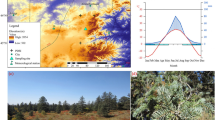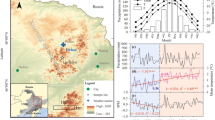Abstract
We investigated scaling of physiological parameters between age classes of Quercus rubra by combining in situ field measurements with an experimental approach. In the in situ field study, we investigated changes in drought response with age in seedlings, juveniles, and mature trees of Q. rubra. Throughout the particularly dry summer of 1995 and the unusually wet summer of 1996 in New England, we measured water potential of leaves (ΨLeaf) and gas exchange of plants at three sites at the Harvard Forest in Petersham, Massachusetts. In order to determine what fraction of the measured differences in gas exchange between seedlings and mature trees was due to environment versus ontogeny, an experiment was conducted in which seedlings were grown under light and soil moisture regimes simulating the environment of mature trees. The photosynthetic capacity of mature trees was three-fold greater than that of seedlings during the wet year, and six-fold greater during the drought year. The seedling experiment demonstrated that the difference in photosynthetic capacity between seedlings and mature trees is comprised equally of an environmental component (50%) and an ontogenetic component (50%) in the absence of water limitation. Photosynthesis was depressed more severely in seedlings than in mature trees in the drought year relative to the wet year, while juveniles showed an intermediate response. Throughout the drought, the predawn leaf water potential (ΨPD) of seedlings became increasingly negative (–0.4 to –1.6 MPa), while that of mature trees became only slightly more negative (–0.2 to –0.5 MPa). Again, juveniles showed an intermediate response (–0.25 to –0.8 MPa). During the wet summer of 1996, however, there was no difference in ΨPD between seedlings, juveniles and mature trees. During the dry summer of 1995, seedlings were more responsive to a major rain event than mature trees in terms of ΨLeaf , suggesting that the two age classes depend on different water sources. In all age classes, instantaneous measurements of intrinsic water use efficiency (WUEi), defined as C assimilation rate divided by stomatal conductance, increased as the drought progressed, and all age classes had higher WUEi during the drought year than in the wet year. Mature trees, however, showed a greater ability to increase their WUEi in response to drought. Integrated measurements of WUE from C isotope discrimination (Δ) of leaves indicated higher WUE in mature trees than juveniles and seedlings. Differences between years, however, could not be distinguished, probably due to the strong bias in C isotope fractionation at the time of leaf production, which occurred prior to the onset of drought conditions in 1995. From this study, we arrive at two main conclusions:
Similar content being viewed by others
Author information
Authors and Affiliations
Additional information
Received: 14 July 1999 / Accepted: 10 January 2000
Rights and permissions
About this article
Cite this article
Cavender-Bares, J., Bazzaz, F. Changes in drought response strategies with ontogeny in Quercus rubra: implications for scaling from seedlings to mature trees. Oecologia 124, 8–18 (2000). https://doi.org/10.1007/PL00008865
Issue Date:
DOI: https://doi.org/10.1007/PL00008865




